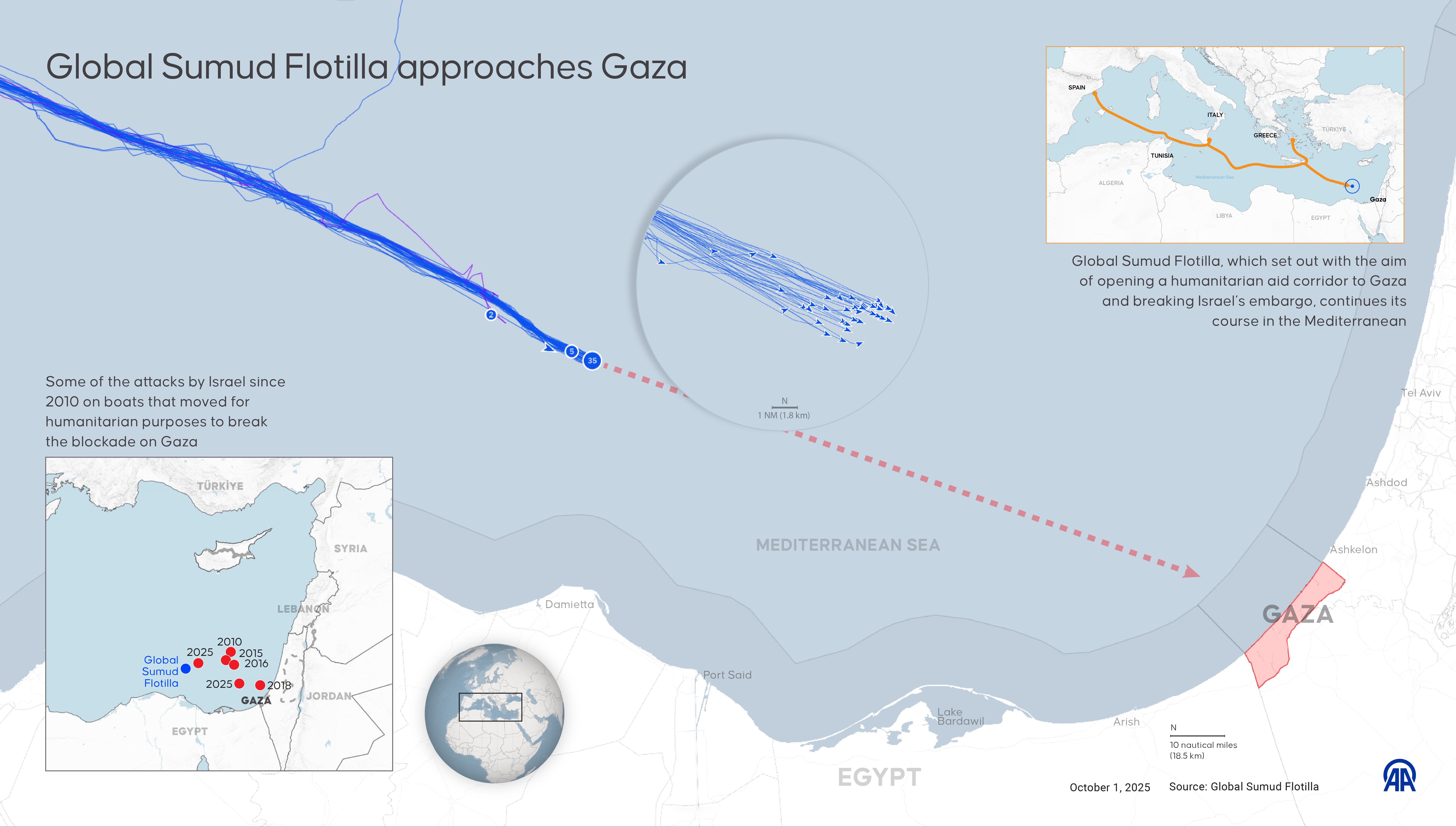Global Sumud Flotilla Approaches Gaza Map


Alex Cartwright
Senior Cartographer & GIS Specialist
Alex Cartwright is a renowned cartographer and geographic information systems specialist with over 15 years of experience in spatial analysis and data...
Geographic Analysis
What This Map Shows
The "Global Sumud Flotilla Approaches Gaza" map visually represents the maritime route taken by a humanitarian flotilla aiming to reach the shores of Gaza. This visualization provides crucial insights into the geographic context of this mission, highlighting the proximity of various countries and maritime boundaries, as well as the geopolitical significance of the region. The map not only illustrates the planned trajectory of the flotilla but also emphasizes the complexities involved in navigating these waters, which are fraught with political tensions and military oversight.
Deep Dive into Humanitarian Maritime Efforts
Historically, maritime humanitarian efforts have played a pivotal role in addressing crises in conflict zones. The Global Sumud Flotilla is part of a broader movement that seeks to provide aid and support to the people of Gaza, who have faced numerous challenges due to blockades and ongoing conflict. These flotillas are typically organized by non-governmental organizations (NGOs) and grassroots movements that aim to raise awareness and generate international support for humanitarian causes.
Interestingly, the term "Sumud" translates to "steadfastness" in Arabic, encapsulating the resilience of the Palestinian people. This spirit of steadfastness is often reflected in various humanitarian initiatives that strive to bring essential supplies and support to those in need. The flotilla's route is not merely a navigation path; it symbolizes hope and solidarity for many who feel isolated due to ongoing geopolitical tensions.
The waters surrounding Gaza are particularly significant, bordered by the Mediterranean Sea and marked by complex territorial waters. The map highlights not only the intended route of the flotilla but also the challenges that exist, including naval blockades and the international maritime laws that govern these waters. For instance, the Israeli naval blockade has been a point of contention, leading to numerous confrontations between humanitarian vessels and military forces.
The flotilla's approach to Gaza brings to light the role of international maritime law, which seeks to protect humanitarian missions. However, the enforcement of these laws can be inconsistent, leading to debates over the legality of such missions. The delicate balance between humanitarian efforts and national security concerns creates a unique dynamic that is crucial for understanding the broader implications of maritime interventions in conflict zones.
Regional Analysis
When examining the map, it's essential to consider the geopolitical landscape of the Mediterranean region. The countries surrounding this area, including Israel, Egypt, and Lebanon, each have their own maritime policies and regulations that impact the flotilla's journey. For example, Egypt's control over the Rafah border crossing plays a crucial role in the movement of goods and people into Gaza, while Israel's naval presence significantly affects maritime routes.
Moreover, the map reflects the strategic significance of the Gaza Strip, which has been the focal point of numerous conflicts and humanitarian crises. The flotilla's intended path may cross through international waters, yet it remains closely monitored by naval forces due to the heightened military presence in the area. This situation creates a complex environment where humanitarian efforts must navigate not only physical but also political obstacles.
Additionally, the map can prompt discussions about the role of neighboring countries in humanitarian efforts. For instance, Turkey has been a significant supporter of such flotillas, often providing logistical and financial backing. The varying levels of support and intervention by different countries highlight the diversity of approaches to humanitarian aid in the region.
Significance and Impact
The significance of the Global Sumud Flotilla extends far beyond its immediate humanitarian goals. It serves as a reminder of the ongoing struggles faced by the people of Gaza and the international community's responsibility towards humanitarian crises. The flotilla aims to draw attention to the dire conditions in Gaza, where access to basic necessities like food, medical supplies, and clean water remains limited due to the blockade.
What's fascinating is how these maritime missions can influence public opinion and policy on a global scale. By bringing international attention to the plight of Gazans, organizations behind the flotilla hope to encourage dialogue and push for policy changes that could alleviate the humanitarian situation. Current trends indicate an increasing mobilization of civil society groups advocating for humanitarian access, which may lead to shifts in governmental policies in the long term.
Furthermore, the impact of such missions can resonate beyond the immediate region, fostering discussions around humanitarian law, the responsibilities of nations toward refugees, and the importance of international solidarity. As the Global Sumud Flotilla approaches Gaza, it exemplifies the complexities of aiding communities in crisis while navigating the geopolitical realities of the region.
In conclusion, the map not only provides a visual representation of a humanitarian mission but also encapsulates the intricate layers of geopolitics, maritime law, and human resilience. The Global Sumud Flotilla stands at the intersection of these elements, embodying the hope for a more compassionate and just world.
Visualization Details
- Published
- October 1, 2025
- Views
- 50
Comments
Loading comments...